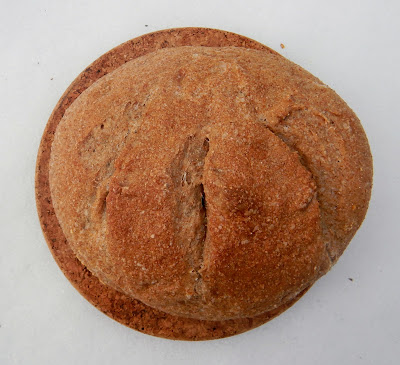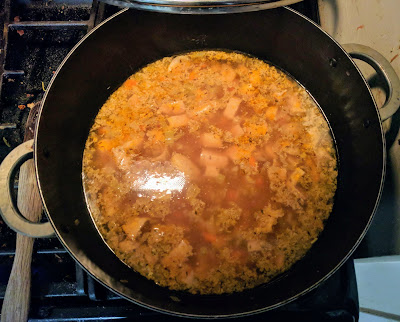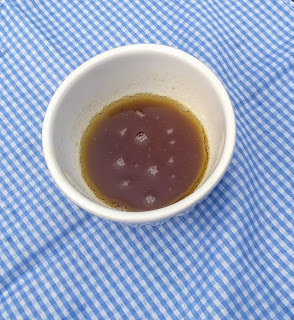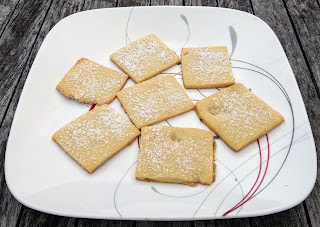Bread
Bread isn't just one thing in Tyria. There are a dizzying variety of loaves, rolls, and flatbreads produced across the continent and I debated for a while which one to share with you. In the end, I decided to go with this crusty Krytan bread. The ingredient list is simple, but don't let that fool you, it is a delicious bread. Just be sure to take your time with it. Rushing won't get you anywhere. Because this bread lacks any fat or sugar, it really depends on thorough kneading and slow cool rises to bring out its best texture and flavour. Also, much like your Terran French bread, it does best when the loaves are formed into shapes with a lot of surface area and cooked with steam.
1 I used 825g of hard whole wheat flour for my bread. If you would like to more closely approximate the semi-hard flour of Kryta, you can use a combination of hard and soft flours: ~600g of hard flour to 225g of soft flour. The dough may need slightly less kneading due to the lower gluten content. Back
2 If you use a machine to do your kneading, be sure to use ice water here, otherwise the dough will get too warm. Back
3 If this happens, continue with the recipe as written but try to cool it down a bit for subsequent rises and do your best to catch it before it hits this point on the next rise. Back
4 Other shapes are also possible. I'm just sticking with a couple classics for simplicity. Feel free to experiment. Shapes that maximize crust/surface area tend to work best for Krytan bread. Back
5 Batards and baguettes use the same shaping. Baguettes simply use half as much dough for a loaf of the same length so they end up much skinnier. Back
6 Cornmeal on its own is sufficient. I usually grease the pans first however as I find the grease helps hold the cornmeal in place and ensure a thin, even layer. Back
7 A vertical slash will cause the dough to fall open and spread sideways during baking. A (nearly) horizontal cut will encourage it to spring upward rather than outward. Back
Krytan Bread
Ingredients
- 2 tsp. active dry yeast
- 1/2 c. warm water
- 825g whole wheat flour1
- 2 1/2 tsp. coarse sea salt
- 1 1/2 c. cold water2
- ~1/2 c. additional water, for kneading
Directions
- Add the yeast to the warm water and set aside for 10 minutes.
- Combine flour(s) and salt and mix well.
- Make a well in the centre of the flour and pour in the yeast mixture and the cold water.
- Working from the centre outward, gradually mix the flour into the liquids.
- Turn the dough out onto your work surface and begin kneading. Wet your hands as you go, gradually incorporating more water into the dough. You want to work in ~an additional 1/2 c. of (cold) water.
- If you are a very efficient kneader 20 minutes might be enough. Personally I would recommend at least 40 minutes of kneading (if you're doing it by hand). The dough will be relatively stiff when you start kneading it, but should be soft and silky by the time you finish.
- Shape the dough into a ball and place in a covered bowl to rise. It is very important to let this dough rise in a COOL place! Do not try to warm it up or speed it up. The temperature should be 20°C (68°F) or less. Absolutely do not let the dough warm above 21°C (70°F)!
- The first rise should take 2-3 hours. (Slower is better.) When it's done a hole made by a wet finger should stay, not fill in, not sink back. If it immediately begins to fill in, it needs more time to rise. If it sighs and sinks back, it's a sign that it should've been knocked back a bit earlier3.
- Knock the dough back. Press out as much gas as possible and maybe knead it a few strokes.
- Shape it into a ball again and put it back in its covered bowl to rise again. The second rise should take ~2 hours at 20°C (68°F). Check when the rise is done as before, with a wet finger pressed ~1cm into the dough.
- After the second rise, the dough is ready to shape. If you will be making batards, divide the dough into two equal portions. For baguettes, four equal portions4.
- Shape each portion into a smooth ball, pulling the gluten taut across the surface. Cover lightly and allow to rest for at least 10 minutes. (20 if the dough seems at all sticky.)
- Working with one ball of dough at a time, press into an oblong ~2/3 as long as you'd like the final loaf to be.
- Grab each of the short ends and fold them in to meet in the middle. Press or roll to return the dough to the same thickness as the original oblong (~2.5cm/1" for a batard).
- Fold the dough in half lengthwise and seal the edges.
- Roll the dough back and forth, applying gentle pressure, to slowly work it out to the desired length.
- Repeat with remaining balls of dough5.
- Alternatively, shape into four small round loaves (pictured above).
- Once the loaves are shaped, I like to transfer them to a cornmeal dusted baking sheet6 for their final rise.
- Set in a cool place to rise, UNCOVERED. Unlike most breads, Krytan bread does not want a humid environment for its final rise.
- Place an empty pan (one that you don't mind potentially warping or rusting) on the bottom rack of the oven. Set the second rack above the empty pan.
- Preheat oven to 230°C (450°F).
- Spritz risen loaves generously with water.
- Slash the loaves. Be sure to cut long, nearly horizontal slashes. Do not cut down into the loaf7.
- Quickly and carefully pour 1-2 c. of boiling water into the empty pan in the bottom of them oven.
- Place the bread (on its cornmeal dusted pan) on the top rack above the pan of boiling water.
- Bake in a hot, steamy oven for 10-20 minutes. (5-10 minutes for baguettes.)
- Once the crust begins to colour, remove the pan of water and reduce heat to 180°C (350°F) and continue baking for another 10-20 minutes. (More time for batards, less time for baguettes.)
1 I used 825g of hard whole wheat flour for my bread. If you would like to more closely approximate the semi-hard flour of Kryta, you can use a combination of hard and soft flours: ~600g of hard flour to 225g of soft flour. The dough may need slightly less kneading due to the lower gluten content. Back
2 If you use a machine to do your kneading, be sure to use ice water here, otherwise the dough will get too warm. Back
3 If this happens, continue with the recipe as written but try to cool it down a bit for subsequent rises and do your best to catch it before it hits this point on the next rise. Back
4 Other shapes are also possible. I'm just sticking with a couple classics for simplicity. Feel free to experiment. Shapes that maximize crust/surface area tend to work best for Krytan bread. Back
5 Batards and baguettes use the same shaping. Baguettes simply use half as much dough for a loaf of the same length so they end up much skinnier. Back
6 Cornmeal on its own is sufficient. I usually grease the pans first however as I find the grease helps hold the cornmeal in place and ensure a thin, even layer. Back
7 A vertical slash will cause the dough to fall open and spread sideways during baking. A (nearly) horizontal cut will encourage it to spring upward rather than outward. Back




Comments
Post a Comment